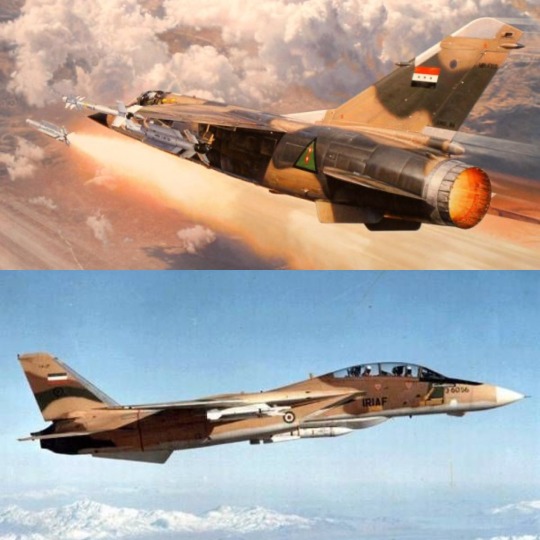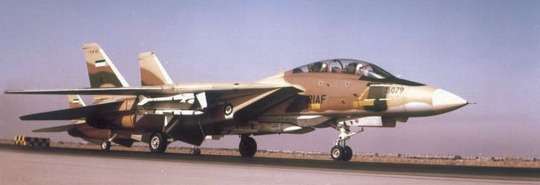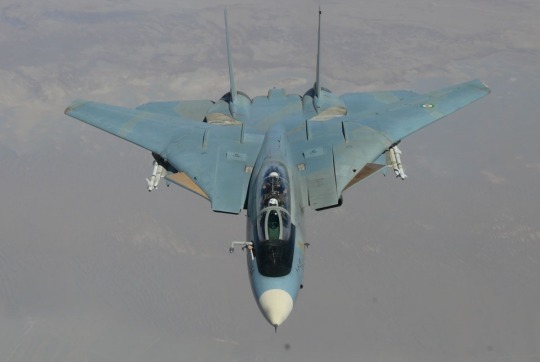#f1eq
Explore tagged Tumblr posts
Text

17 January 1991. An unarmed USAF EF-111A Raven Wedge 52, crewed by Captains James A. Denton and Brent D. Brandon achieved a combat victory against an Iraqi Dassault Mirage F1EQ which they maneuvered into the ground. The only F-111 to achieve an aerial victory.
@ron_eisele via X

13 notes
·
View notes
Text
Iran - Iraq air war’s best aircraft

Iran’s F-14A Tomcat Vs Iraq’s Mirage F.1EQ
The Iran Iraq conflict in the air was a dangerous battlefield, and an interesting clash of different ideas on how air combat should be fought as Iranian and Iraqi aircrew were trained in very different ways but also a interesting clash of Soviet against American made aircraft and weapons. During the war one aircraft from each side stood out as the top tier fighters of their respective air forces which were:
the US-made Grumman F-14A Tomcat used by the IRIAF

By far the most powerful aircraft on the battlefield, the Tomcat was an advanced 4th generation fighter aircraft with an astonishing AN/AWG-9 weapon control system, powerful avionics and equipped with some superb weapons, most notably the Aim-54 long range missiles, and yet possess incredible manoeuvrability thanks to lessons learned from Vietnam despite its incredible size compared to other aircraft of the time. One of the most important reasons the Tomcats were so effective were the aircrews who had been trained in the US to top western standards, giving the pilots fantastic understanding of how to fight and react in the heat of combat and would go a long way when facing a enemy of much greater numbers. 80 aircraft had been ordered in 1974 and the first aircraft would be delivered in 1976 with a total of 79 aircraft in country by the time the revolution ended the contract. Apart from some small downgrades to a few of the avionics and the Phoenix missiles the aircraft were the most powerful fighters in the region at the time and remained effective even during the 80s.
The downsides to the IRIAF Tomcats were small numbers available at the start of the conflict (60 in 1981) and the numbers went down to about 20 aircraft due to combat losses and lack of available spares. The Tomcat was a highly sophisticated aircraft and needed complex parts and highly trained technicians to maintain, both were not really available to a cut-off Iran who had to rely on self-knowledge and the black market for parts. Also the US had kept the Iranians from understanding how the complicated avionics worked so when the US left, the Iranians had a hard time knowing how these parts could be fixed, only some time did they know how to fix these parts. And finally these Tomcats, being original A models were fitted with the troublesome Pratt & Witney TF30 engines and although they were the improved 414 model they still proved problematic, none other than 9 aircraft would be lost due to engine related issues, and each loss was painful as of course no replacement aircraft could be procured.
And on the Iraqi side there was the French-made Dassault Mirage F.1EQ-2

First ordered in 1977 and starting to arrive in Iraq in 1981 the Mirage F.1 was a big step up from the line of Soviet built aircraft used by the IrAF. Unlike the Soviet MiG 21 and 23 which were downgraded from Russian standards and were rather poorly equipped, the F.1 was very modern, brilliantly equipped and the aircraft could use a whole host of modern state of the art weapons and reconnaissance pods although for this comparison I’m focusing on the F.1EQ-2 interceptor variant. The EQ.2 used the Standard Thompson-CSF Cyrano IV Radar, a system capable of using three different modes and was compatible with what was arguably some of the best air-to-air weapons available such as the Mantra R550 Magic and the Super 530 missiles. The simple systems and the single engine made for a lightweight and easy aircraft to maintain and fly, and unlike the Iranians who were cut off, the Iraqis could acquire as many as it could afford and almost 100 were in the country by 1988/89. The aircraft certainly made its mark and gave the timid IrAF pilots a new level of confidence when facing more advanced Iranian aircraft.
The downsides to this aircraft were mainly the lack of availability, most of the fighting during the war was done with the older and far less capable MiGs and Sukhois already in inventory as delays in the development and production, meaning the F.1s would be slow to arrive and not in any substantial numbers until later on. Also Iraqi requests for a heavier payload capacity slowed down the deliveries of the aircraft. Also a big issue was Pilot training, unlike the Iranians who had been trained to high standards by the Americans, the Iraqis had been trained to rather sub-standard soviet doctrine built around the idea of a IADS system, but the pilots received very little air-combat training, and often had to learn its own methods or those of its Arab neighbours. Along with the new F.1s the French also trained the Pilots to much better standard, there were even air-combat courses made available by Dassult in France and a number of Iraqi pilots took these to acquire much needed skills and although some of these became brilliant pilots, they were too few in number and Iranian aircrews would always have an edge in terms of pilot capabilities compared to average Iraqi drivers.


Overall the F-14As shot down an estimated 30 F.1EQs compared to about 6 Tomcats downed by the Mirages (the F-14s would end the war with a tally of 160-20 and the F.1EQs with 35-30). In my opinion the F-14A was the better aircraft in a number of ways. The main one being the Tomcat’s strongest trait: it’s AWG-9 weapon control system which possessed far greater range than the simple Thompson-CSF system in the F.1 and the AWG-9 was largely immune to jamming, even by some of the more powerful systems employed by the Soviets and Iraqis. With this the Tomcats could control the battlefield, choosing when to engage and the Tomcat could engage long before the Mirage thanks to its main weapon: the Aim-54A Phoenix with its long range capabilities could knock out Iraqi aircraft before they could even come close to weapon range themselves.
If the fighting got into visual range and into a true dogfight a number of factors would come into play, the F-14A posses fantastic low-speed agility especially at lower altitudes, but a Tomcat crew would have to be very careful of the notorious compressor stall issue with the TF30s but also the Mirage F.1s are a much smaller aircraft and use a single engine which is a good trait in combat but also have no worry about the stall issue. Pilot skill would play a big part here and the F-14s crew were still better in skill but F.1 pilots were better trained than previous MiG pilots so it would even the score and finally at this sort of range some good weapons are needed. The Mantra R530F Super was a far superior medium range missile to the older Aim-7E-4 Sparrow which hadn’t changed much since the 70s and for close range work both the Aim-9P and the Mantra 550 Magic Mk1/2 were relatively even in terms of capabilities.
Both air forces used different tactics to employ their aircraft effectively, the Iranians typically used the US combat spread technique and often engaged first with the large Phoenix missile and long range at about 50 miles and the poorly equipped Iraqi aircraft would often be shot down before they knew what hit them and fled the first chance they got. The Iraqis developed a combat method known as “Giraffing” in which aircraft would approach at very low level then climb under the Tomcats to pounce them from an unexpected angle and this resulted in a number of Tomcats shot down, 4 were shot down in a few days in November 1981 which gave a boost the the Iraqi pilots to take of the seemingly invincible F-14s.
And yet despite this the Iranian Tomcats remained the dominant fighter of the war, a combination of a fantastic aircraft and brilliantly trained aircrew put them ahead of the Iraqis even with the advanced F.1s, only the lack of aircraft and parts prevented them from ever fully establishing air superiority over the hostile skies of the conflict. The tomcats ended the war a clear winner but were low in numbers when the conflict ended whilst the Iraqi F.1s would earn a reputation as a effective multi-role aircraft, being used in the air interception role, ground attack role and anti-shipping role.
Today the IRIAF Tomcats soldier on, with an estimated 20-40 aircraft still in service

Whilst unfortunately the 1991 Gulf war and the 2003 invasion of Iraq led to the complete end to the IrAF with most of its Mirage F.1EQs destroyed or grounded due to lack of parts

Ironically a number of Iraqi F.1EQs fled to Iran before the start of the 1991 Gulf war and these were seized by the Iranians as compensation for the conflict they started. These still fly with the IRIAF alongside the very F-14s they once challenged.

#grumman f 14 tomcat#f14tomcat#f14atomcat#f14#f14a#grumman#dassault mirage f1#mirage f1#f1eq#fighter jet#fighter aircraft#air combat#aircraft comparison#iran#islamic republic of iran air force#iriaf#iraq#iraqi air force#iraf
58 notes
·
View notes
Text

January 17th 1991 – An UNARMED USAF EF-111 A Raven, crewed by Captain James A. Denton and Captain Brent D. Brandon amazingly scored a kill against an enemy Iraqi Dassault Mirage F1EQ. The completely unarmed EF-111 managed to maneuver the enemy fighter into the ground, making it the one and only F-111 to achieve the impressive distinction of an aerial victory over another aircraft.
135 notes
·
View notes
Photo

Set mascherine mamma e figlia con elastico per capelli abbinato,se scorrete le foto ci sono varie versioni molto simili tra loro,ovviamente se siete interessate solo a un pezzo invece di tutti e 3 non ci sono problemi,se vi va mi potete contattare 😘💙 #mammepermano #mammalikeloop #ymumlike #mammeduepunto0 #mammefollowmamme #mammalikeloop2 #girlpowergirl03 #mascherine #coordinato #scrunchies #fattoamano #handmade #handmadewithlove (presso Lago Patria) https://www.instagram.com/p/CGvWK8-F1EQ/?igshid=qs6j92xrrosg
#mammepermano#mammalikeloop#ymumlike#mammeduepunto0#mammefollowmamme#mammalikeloop2#girlpowergirl03#mascherine#coordinato#scrunchies#fattoamano#handmade#handmadewithlove
0 notes
Photo

An unarmed USAF EF-111 A Raven, crewed by Captain James A. Denton and Captain Brent D. Brandon scored a kill against an Iraqi Dassault Mirage F1EQ, which they managed to maneuver into the ground, making it the only F-111 to achieve an aerial victory over another aircraft.
0 notes
Photo

An unarmed USAF EF-111 A Raven, crewed by Captain James A. Denton and Captain Brent D. Brandon scored a kill against an Iraqi Dassault Mirage F1EQ, which they managed to maneuver into the ground, making it the only F-111 to achieve an aerial victory over another aircraft.
0 notes